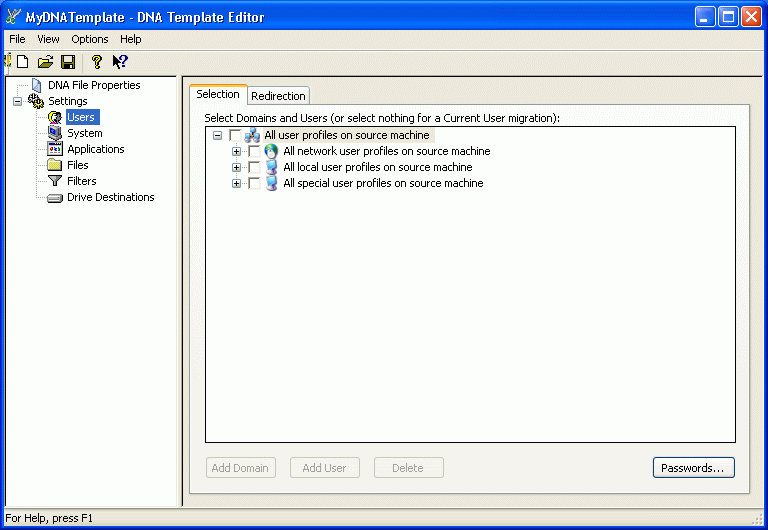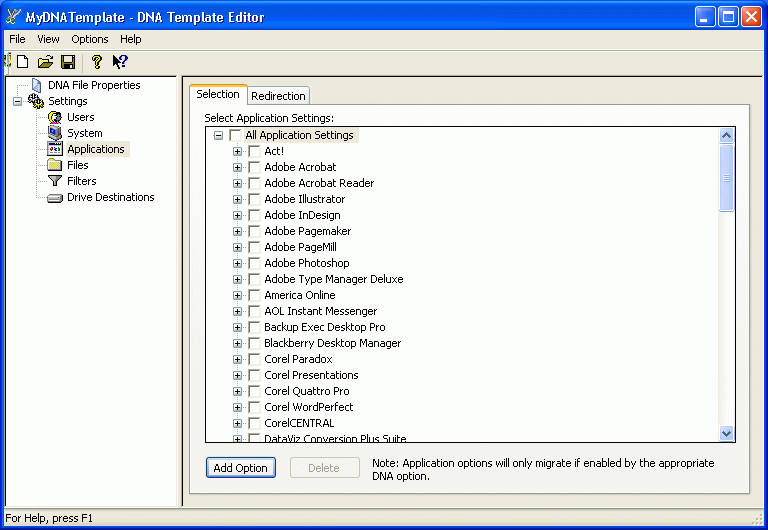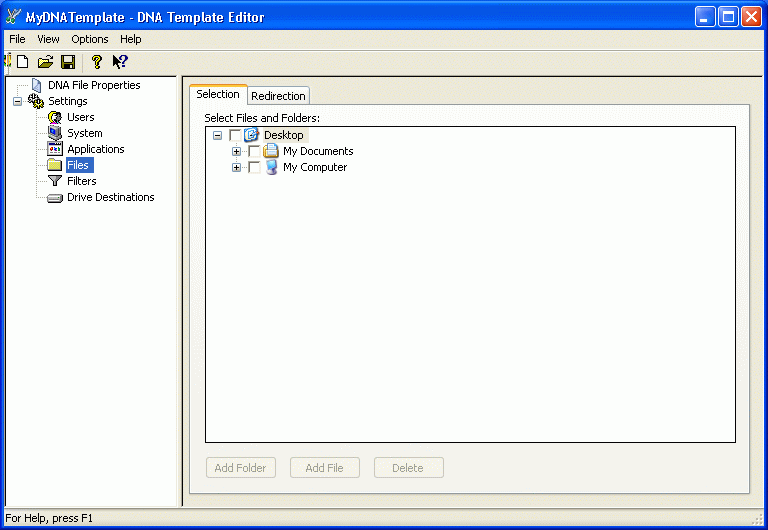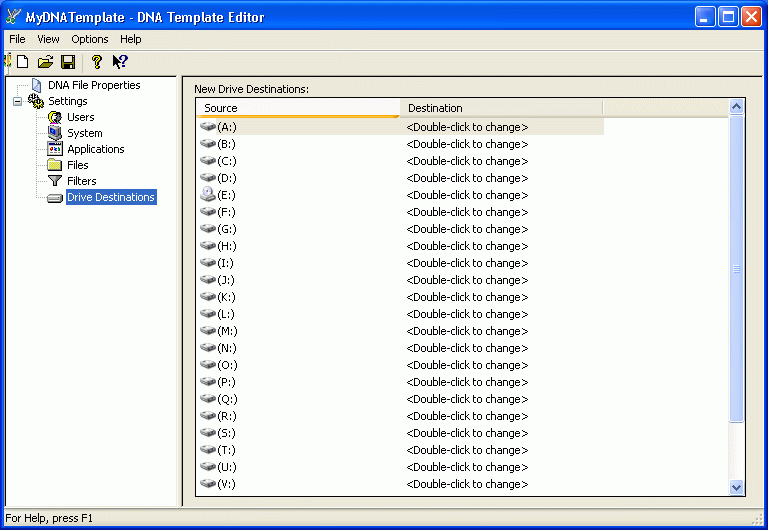5.2 Configuring the Template
When you create a template, you select settings for users, the system, applications, files, filters, and drive destinations.
The following sections provide additional information:
5.2.1 Configuring Users Settings
To configure the settings for the template if you want to migrate more than the current user:
NOTE:You must have full administrator privileges to migrate multiple users in Windows NT or Windows 2000.
-
Open the DNA Template Editor from the menu.
-
Click in the left pane of the Template Editor window.

-
Select the domains and users for migration.
Network Users: The network user branch displays users belonging to NT Domains or to Active Directory*. If both types of directory systems are implemented, they are both displayed. When you expand an NT Domain branch, only users display under the Domain name. If you expand an Active Directory branch, Active Directory containers display along with the users beneath the containers. If you migrate User Profiles associated with domain accounts (or Active Directory accounts), you must ensure that the user logged in at the time of the migration has administrative rights locally and is a member of the Domain Admin group. Having a user with these permissions logged in during migration allows the creation of accounts on the domain if you are changing domain membership.
Local Users: The local users branch lets you add local user profiles. If you migrate user profiles associated with local accounts, you must ensure that the user logged in at the time of migration has administrative rights locally. Having a user with these permissions logged in during migration allows the creation of accounts on the local system. Additionally, you can specify how passwords are created for new accounts by clicking the button.
Special Users: The special users branch lets you add special local user profiles and is included for selecting the administrator or default user on Windows NT* or Windows 2000 systems. The default user profile settings can be migrated so that all subsequent users logging in to a Windows NT or Windows 2000 system get specified default or applications settings.
-
To assign a password, click .
-
Select one of the following:
-
-
Click to enter a password or options for the randomly generated password, then click .
Select to prompt users for a password.
-
-
To redirect users, select the users you want to migrate by clicking the check box to the left of the username.
-
Click the tab.
-
Double-click the destination column of the domain or Active Directory container branch.
-
Specify the new domain or Active Directory container name.
All users under the specific user branch are relocated to the new domain name or Active Directory container on the destination unless the user is specifically redirected to a different domain or Active Directory container.
-
To redirect all users in a specific domain or Active Directory container, double-click the users’ destination column.
You can specify a different domain or Active Directory container and a new username. The format should be NT Domain name or Active Directory container name\ User Name.
Users identified for the destination cannot be mixed wildcards, but must use the * wildcard to replace an entire string
5.2.2 Configuring System Settings
To configure System settings:
-
Open the DNA Template Editor from the menu.
-
Click in the left pane of the Template Editor window.

-
Select the system settings.
-
To add a setting group, click and type the name of the option group.
-
To add a setting, expand the list to show all the system settings in a category, click , and type the name of the setting.
Unless you are certain you want to migrate everything in a category, be sure to expand the list to display all the items and subcategories.
5.2.3 Configuring Applications Settings
To configure Applications settings:
-
Open the DNA Template Editor from the menu.
-
Click in the left pane of the Template Editor window.

-
Select the applications.
-
To add an application, click and type the name of the option group.
-
To add a setting, expand the list to show all the application settings in a category, click and type the name of the setting.
-
To redirect an application:
-
Select the application.
-
Click the tab.
-
Double-click the column.
-
Enter the path where you want to redirect the application or click to locate the path.
-
Click
-
Repeat steps 6a–6e for each additional application.
-
5.2.4 Configuring Files Settings
To configure the Files settings:
-
Open the DNA Template Editor from the menu.
-
Click in the left pane of the Template Editor window.

-
Select the files and folders.
-
To add a folder, click and enter a name for the new folder.
-
To add a file, click and enter a name for the new file.
-
To redirect a file or folder:
-
Select that file or folder
-
Click the tab.
-
Double-click the column.
-
Enter the path where you want to redirect the file or folder or click to locate the path.
-
Click
-
Repeat steps 6a–6e for each additional file or folder.
-
5.2.5 Adding Drive Destinations
To add drive destinations:
-
Open the DNA Template Editor from the menu.
-
Click in the left pane of the Template Editor window.

-
Double-click the column.
-
Select the drive letter from the drop-down menu.
NOTE:Files on the source system that are stored in folders recognized by the Windows Registry are automatically migrated to the equivalent folder on the destination system. If you want to migrate them elsewhere, add file and folder destinations in the Files category.